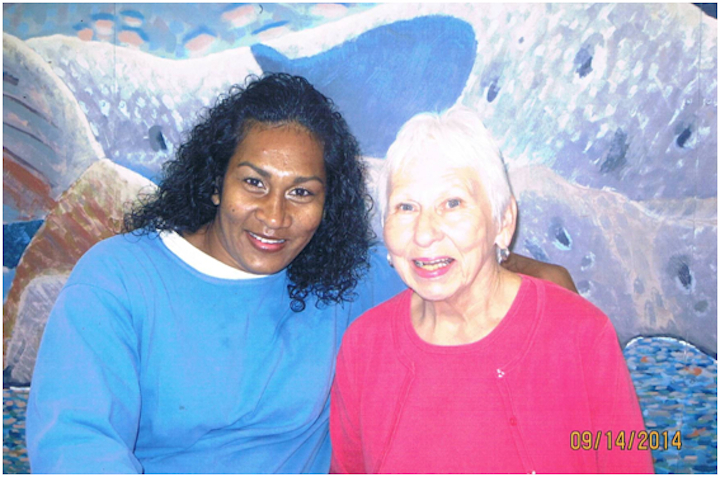
Rajeshree Roy with Carolyn Miller, a close friend, on a visit at Central California Women’s Facility (CCWF).
IN SOLIDARITY
Something very significant is brewing in California right now. Female prisoners in the Yuba County Jail are organising in solidarity with immigrants n detention.
Yesterday (Monday 14th December) a group of women began a hunger strike, joining hundreds of other detainees taking part in hunger strikes at facilities across the country.
You may or may not have heard about the fasting and hunger strikes going on in immigrant detention facilities across the country. Up and down the country–in the Hutto Immigrant Detention Center in Texas; in an immigrant detention center in the high desert city of Adelanto, California; in the Krome Service Processing Center in Florida; and in Alabama, in El Paso, Texas and in Lasalle, Louisiana, too.
Vikki Law has covered these as a trend. And they are. Collectively, the strikes are known as the #FreedomGiving Strikes and they were launched on Thanksgiving by hundreds of South Asian and African detainees at three separate facilities. The movement has grown.
Never before (to my knowledge) has the political resistance of detained immigrants run in cohort with the political action of citizens in county or state facilities. The Yuba County Jail rents space to Immigration and Customs Enforcement (ICE) to detain people. For the first time, women in criminal custody are fasting with detainees in immigration custody as an act of solidarity. Phenomenal. Principled. Inspiring.
The Yuba Co. Jail hunger strike is led by, and in support of, Rajashree Roy (above). You can read a longer detailed account of Roy’s journey here.
To be brief, Roy faces deportation back to Fiji where she has not lived since she was 8-years-old. As a child, Roy suffered sexual abuse and upon relocation to the United States never received counseling or help. By the time she was in her teens she was both attempting suicide and robbing and beating people. She was very troubled and the undelrying causes had never been addressed.
Sentenced as an adult at age 16, Rajashree spent 17-years at Central California Women’s Facility (CCWF). Nine years later, struggling to survive and feed her children while in an abusive relationship, she stole a garden hosepipe from a store, a misdemeanor petty theft.
Due to her priors, the District Attorney set bail at $1million and offered a 25-to-life sentence. In 2011, Roy accepted a plea bargain of seven years. In November 2014, she qualified for release under Prop 47. When Rajashree Roy stepped foot out of CCWF, she was picked up by ICE and slated for deportation back to Fiji, away from her children.
After years of silence due to shame and stigma as an abuse survivor and ‘criminal’, Rajashree Roy has gained confidence through peer and advocacy support and decided to be public with her story and fight for herself and others.
“We are locked up together and refuse to be divided into immigrants and citizens. None of us belong in this cage separated from our families. We join the brave immigrant hunger strikers across the country in fasting to force recognition of our humanity,” says the staement of Roy and her fellow hunger strikers at Yuba County Jail.
WHAT TO DO
- Join community organizers at ASPIRE, the nation’s first pan-Asian undocumented youth-led group, at a fast in solidarity outside Yuba County Jail.
- Support the #FreedomGiving strikers by signing the petition.
- Help raise funds for Rajashree’s $10,000 bond.
- Write letters of support to the women on hunger strike:
Rajeshree Roy
Booking No. 229860
Yuba County Jail
P.O. Box 1031
Marysville, California 95901
Booking No. 229860
Yuba County Jail
P.O. Box 1031
Marysville, California 95901
Jessica Bullock
Booking No. 235161
Yuba County Jail
P.O. Box 1031
Marysville, California 95901
Booking No. 235161
Yuba County Jail
P.O. Box 1031
Marysville, California 95901
Tisha Sartor
Booking No. 233892
Yuba County Jail
P.O. Box 1031
Marysville, California 95901
Booking No. 233892
Yuba County Jail
P.O. Box 1031
Marysville, California 95901
Kyra Beckles
Booking No. 234664
Yuba County Jail
P.O. Box 1031
Marysville, California 95901
Booking No. 234664
Yuba County Jail
P.O. Box 1031
Marysville, California 95901
Juanita Thomas
Booking No. 235553
Yuba County Jail
P.O. Box 1031
Marysville, California 95901
Booking No. 235553
Yuba County Jail
P.O. Box 1031
Marysville, California 95901
Ana Marquez
Booking No. 235550
Yuba County Jail
P.O. Box 1031
Marysville, California 95901
Booking No. 235550
Yuba County Jail
P.O. Box 1031
Marysville, California 95901


